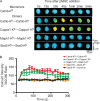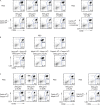Peptide-MHC heterodimers show that thymic positive selection requires a more restricted set of self-peptides than negative selection
- PMID: 20457759
- PMCID: PMC2882826
- DOI: 10.1084/jem.20092170
Peptide-MHC heterodimers show that thymic positive selection requires a more restricted set of self-peptides than negative selection
Abstract
T cell selection and maturation in the thymus depends on the interactions between T cell receptors (TCRs) and different self-peptide-major histocompatibility complex (pMHC) molecules. We show that the affinity of the OT-I TCR for its endogenous positively selecting ligands, Catnb-H-2Kb and Cappa1-H-2Kb, is significantly lower than for previously reported positively selecting altered peptide ligands. To understand how these extremely weak endogenous ligands produce signals in maturing thymocytes, we generated soluble monomeric and dimeric peptide-H-2Kb ligands. Soluble monomeric ovalbumin (OVA)-Kb molecules elicited no detectable signaling in OT-I thymocytes, whereas heterodimers of OVA-Kb paired with positively selecting or nonselecting endogenous peptides, but not an engineered null peptide, induced deletion. In contrast, dimer-induced positive selection was much more sensitive to the identity of the partner peptide. Catnb-Kb-Catnb-Kb homodimers, but not heterodimers of Catnb-Kb paired with a nonselecting peptide-Kb, induced positive selection, even though both ligands bind the OT-I TCR with detectable affinity. Thus, both positive and negative selection can be driven by dimeric but not monomeric ligands. In addition, positive selection has much more stringent requirements for the partner self-pMHC.
Figures






References
Publication types
MeSH terms
Substances
Grants and funding
LinkOut - more resources
Full Text Sources
Molecular Biology Databases
Research Materials

